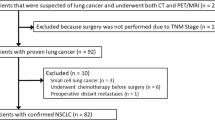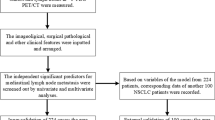Abstract
Aim
To evaluate the role of fluorine-18 fluorodeoxyglucose (18F-FDG) positron emission tomography/computed tomography (PET/CT) radiomics features (RFs) for predicting clinicopathological factors (CPFs) and prognosis in patients with resected lung squamous cell cancer (LSCC).
Material and Methods
Patients with early-stage (stage I–III) LSCC who underwent 18F-FDG PET/CT before surgical resection between August 2012 and February 2020 were analyzed. Patients who received neoadjuvant chemotherapy or radiotherapy were excluded from the study. The maximum standard uptake value (SUVmax) and RFs were extracted from PET images for primary tumors. The diagnostic performances of PET parameters in groups of tumor differentiation, stage, and mediastinal lymph node metastasis (MLNM) status were evaluated. The study endpoints were overall survival (OS) and progression-free survival (PFS). Univariate and multivariate analyses were performed with RFs, SUVmax, and CPFs to find independent predictors of PFS and OS.
Results
A total of 77 patients (5 female, 72 male) were included in the study. SUVmax and GLCM entropy were independently associated with tumor differentiation. The only parameter with significant diagnostic performance for MLNM was GLZLM-SLZGE. Tumor diameter and NGLDM busyness were independently associated with the stage. MLNM and tumor differentiation were found to be independent predictors of PFS. NGLDM contrast and MLNM were independently associated with OS.
Conclusion
Using radiomic features in addition to CPFs to predict disease recurrence and shorter overall survival can guide precision medicine in patients with LSCC.

Similar content being viewed by others
Data Availability
Contact the corresponding author for data requests.
References
Fitzmaurice C, Dicker D, Pain A, Hamavid H, Moradi-Lakeh M, MacIntyre M, et al. The global burden of cancer 2013. JAMA Oncol. 2015;4:505–27.
Perez-Moreno P, Brambilla E, Thomas R, Soria JC, et al. Squamous cell carcinoma of the lung: molecular subtypes and therapeutic opportunities. Clin Cancer Res. 2012;18:2443–51.
Kwon W, Howard BA, Herndon JE, Patz EF Jr, et al. FDG uptake on positron emission tomography correlates with survival and time to recurrence in patients with stage I non-small-cell lung cancer. J Thorac Oncol. 2015;10:897–902.
Kurtipek E, Çayc M, Düzgün N, Esme H, Terzi Y, Bakdk S, et al. (18)F-FDG PET/CT mean SUV and metabolic tumor volume for mean survival time in non-small cell lung cancer. Clin Nucl Med. 2015;40:459–63.
Liu J, Dong M, Sun X, Li W, Xing L, Yu J, et al. Prognostic value of 18F-FDG PET/CT in surgical non-small cell lung cancer: a meta-analysis. PLoS ONE. 2016;11:e0146195.
Fisher R, Pusztai L, Swanton C. Cancer heterogeneity: implications for targeted therapeutics. Br J Cancer. 2013;108:479–85.
Eary JF, Brenner W. Do we need quantitative imaging? Nuklearmedizin. 2020;59:225–6.
Lambin P, Leijenaar RT, Deist TM, Peerlings J, De Jong EE, Van Timmeren J, et al. Radiomics: the bridge between medical imaging and personalized medicine. Nat Rev Clin Oncol. 2017;14:749–62.
Ha S, Choi H, Paeng JC, Cheon GJ. Radiomics in oncological PET/CT: a methodological overview. Nucl Med Mol Imaging. 2019;53:14–29.
Gillies RJ, Kinahan PE, Hricak H. Radiomics: images are more than pictures, they are data. Radiology. 2016;278:563–77.
Aydos U, Ünal ER, Özçelik M, Akdemir D, Ekinci Ö, Taştepe Aİ, et al. Texture features of the primary tumor on (18)F-FDG PET images in non-small cell lung cancer: the relationship between imaging and histopathological parameters. Rev Esp Med Nucl Imagen Mol (Engl Ed). 2021;40:343–50.
Mostafa R, Abdelsamie Kandeel A, Abd Elkareem M, Nardo L, Abdelhafez YG. Pretherapy 18F-fluorodeoxyglucose positron emission tomography/computed tomography robust radiomic features predict overall survival in non-small cell lung cancer. Nucl Med Commun. 2022;43:540–8.
Dissaux G, Visvikis D, Da-Ano R, Pradier O, Chajon E, Barillot I, et al. Pretreatment (18)F-FDG PET/CT radiomics predict local recurrence in patients treated with stereotactic body radiotherapy for early-stage non-small cell lung cancer: a multicentric study. J Nucl Med. 2020;61:814–20.
Nioche C, Orlhac F, Boughdad S, Reuzé S, Goya-Outi J, Robert C, et al. LIFEx: a freeware for radiomic feature calculation in multimodality imaging to accelerate advances in the characterization of tumor heterogeneity. Cancer Res. 2018;78:4786–9.
Hong R, Halama J, Bova D, Sethi A, Emami B, et al. Correlation of PET standard uptake value and CT window-level thresholds for target delineation in CT-based radiation treatment planning. Int J Radiat Oncol Biol Phys. 2007;67:720–6.
Hong R, Halama J, Bova D, Sethi A, Emami B, et al. Gene expression-based classification of non-small cell lung carcinomas and survival prediction. PLoS ONE. 2010;5:e10312.
Attenberger UI, Langs G. How does radiomics actually work?–review. Rofo. 2021;193:652–7.
Shao D, Du D, Liu H, Lv J, Cheng Y, Zhang H, et al. Identification of stage IIIC/IV EGFR-mutated non-small cell lung cancer populations sensitive to targeted therapy based on a PET/CT radiomics risk model. Front Oncol. 2021;11:e721318.
Önner H, Abdülrezzak Ü, Tutuş A. Could the skewness and kurtosis texture parameters of lesions obtained from pretreatment Ga-68 DOTA-TATE PET/CT images predict receptor radionuclide therapy response in patients with gastroenteropancreatic neuroendocrine tumors? Nucl Med Commun. 2020;41:1034–9.
Sun W, Jiang M, Dang J, Chang P, Yin FF. Effect of machine learning methods on predicting NSCLC overall survival time based on radiomics analysis. Radiat Oncol. 2018;13:1–8.
Ahn HK, Lee H, Kim SG, Hyun SH. Pre-treatment 18F-FDG PET-based radiomics predict survival in resected non-small cell lung cancer. Clin Radiol. 2019;74:467–73.
Zhang Y, Oikonomou A, Wong A, Haider MA, Khalvati F. Radiomics-based prognosis analysis for non-small cell lung cancer. Science. 2017;7:1–8.
Carles M, Fechter T, Radicioni G, Schimek-Jasch T, Adebahr S, Zamboglou C, et al. FDG-PET radiomics for response monitoring in non-small-cell lung cancer treated with radiation therapy. Cancers. 2021;13:814.
Chetan MR, Gleeson FV. Radiomics in predicting treatment response in non-small-cell lung cancer: current status, challenges and future perspectives. Eur Radiol. 2020;31:1049–58.
Andre F, Grunenwald D, Pignon JP, Dujon A, Pujol JL, Brichon PY, et al. Survival of patients with resected N2 non–small-cell lung cancer: evidence for a subclassification and implications. J Clin Oncol. 2000;18:;2981–89.
Önner H, Coskun N, Erol M, Karanis MİE. Association of (18)F-FDG PET/CT textural features with immunohistochemical characteristics in invasive ductal breast cancer. Rev Esp Med Nucl Imagen Mol (Engl Ed). 2022;41:11–6.
Ouyang ML, Wang YR, Deng QS, Zhu YF, Zhao ZH, Wang L, et al. Development and validation of a 18F-FDG PET-based radiomic model for evaluating hypermetabolic mediastinal–hilar lymph nodes in non-small-cell lung cancer. Front Oncol. 2021;11:e710909.
Zheng K, Wang X, Jiang C, Tang Y, Fang Z, Hou J, et al. Pre-operative prediction of mediastinal node metastasis using radiomics model based on 18F-FDG PET/CT of the primary tumor in non-small cell lung cancer patients. Front Med (Lausanne). 2021;8:e673876.
Papp L, Rausch I, Hacker M, Beyer T. Fuzzy radiomics: a novel approach to minimize the effects of target delineation on radiomic models. Nuklearmedizin. 2019;58:L9.
Im HJ, Zhang Y, Wu H, Wu J, Daw NC, Navid F, et al. Prognostic value of metabolic and volumetric parameters of FDG PET in pediatric osteosarcoma: a hypothesis-generating study. Radiology. 2018;287:303–12.
Erdi YE, Mawlawi O, Larson SM, Imbriaco M, Yeung H, Finn R, et al. Segmentation of lung lesion volume by adaptive positron emission tomography image thresholding. Cancer. 1997;80:2505–9.
Author information
Authors and Affiliations
Contributions
The study was designed by Mustafa Erol. Material preparation and data collection were performed by Mustafa Erol, Hasan Önner, and İlknur Küçükosmanoğlu. The data analysis was performed by Mustafa Erol and Hasan Önner. The first draft of the manuscript was written by Mustafa Erol and all authors commented on previous versions of the manuscript. All authors read and approved the final manuscript.
Corresponding author
Ethics declarations
Ethical Approval and Consent to Participate
The study was approved by the institutional review board of KTO Karatay University (2020/11), and the requirement for written consent was waived by the institutional review board. All procedures performed in studies involving human participants were in accordance with the Helsinki Declaration as revised in 2013 and its later amendments.
Consent for Publication
Not applicable.
Conflict of Interest
Mustafa Erol, Hasan Önner, and İlknur Küçükosmanoğlu declare no conflict of interest.
Additional information
Publisher's Note
Springer Nature remains neutral with regard to jurisdictional claims in published maps and institutional affiliations.
Rights and permissions
Springer Nature or its licensor holds exclusive rights to this article under a publishing agreement with the author(s) or other rightsholder(s); author self-archiving of the accepted manuscript version of this article is solely governed by the terms of such publishing agreement and applicable law.
About this article
Cite this article
Erol, M., Önner, H. & Küçükosmanoğlu, İ. Association of Fluorodeoxyglucose Positron Emission Tomography Radiomics Features with Clinicopathological Factors and Prognosis in Lung Squamous Cell Cancer. Nucl Med Mol Imaging 56, 306–312 (2022). https://doi.org/10.1007/s13139-022-00774-2
Received:
Revised:
Accepted:
Published:
Issue Date:
DOI: https://doi.org/10.1007/s13139-022-00774-2




